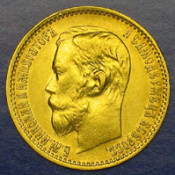
Monetary Regulations approved. Finance reform by S. Yu. Vitte completed
«I have carried out the currency reform the way that the population of Russia did not notice it as if nothing happened…
There was not a single complaint! Not a single misunderstanding from the part of people».
S. Yu. Vitte.
On June 7 (19), 1899 Nikolai II approved the Monetary Regulations which completed the currency reform effectuated by Finance Minister S. Yu. Vitte. As a result, the Russian ruble became completely convertible in gold.
The Regulations included an introductory part and 3 articles: ‘On monetary system’, ‘On monetary circulation’, ‘On St. Petersburg Mint (Mint management; Objects and order of activity of the Mint).
The Monetary Regulations of 1899 united all statutes of the currency reform 1895-1897 which resulted in silver ruble abolishment as the essential monetary unit of the Russian Empire. From August 29, 1897 until 1915 under the decree on emissive operations of the State Bank which was authorized to issue the banknotes secured by gold, the silver ruble became the physical means of paying bound to the new monetary unit – golden ruble.
In accordance with Monetary Regulations ruble contained 17.424 parts of the pure gold. For instance, the 10 rubles coin of regular stamp contained 1 zolotnik 74.24 parts of gold which equaled to 7.74 grams.
The coins of silver and copper became an auxiliary means of paying that is why silver money were obligatory for acceptance only for sums under 25 rubles; as to copper base coins, this sum did not exceed 3 rubles. The sum of silver coins put into circulation in the Russian Empire must not exceed 3 rubles per head. At the same time the high-standard coins were considered those which nominal was 1 ruble, 50 copecks and 25 copecks which contained 900 parts of pure silver and 100 parts of copper. Silver coins with a face value of 20, 15, 10 and 5 copecks contained 500 parts of silver and 500 parts of copper. All silver coins were produced under the condition of ‘closed coinage’ unlike golden coins authorized for ‘free coinage’.
As a result of the currency reform by count S. Yu. Vitte, the structure of monetary circulation of Russia changed. For the period until 1914 Russia obtained the stable currency secured by gold. If in 1895 banknotes composed 91.7% of the total money supply, by January of 1914 the total money supply consisted of gold (21.2%), silver (5.4%) and banknotes (73.4%).
The currency reform 1895-1897 strengthened the domestic and foreign ruble rate, improved the investment climate within the country and contributed to involvement of the national and foreign capitals to the Russian economy.
At the beginning of the First World War in 1914 the exchange of money for gold stopped.
Lit.: Власенко В. Е. Денежная реформа в России 1895—1898. Киев, 1949; Материалы по денежной реформе 1895—1897. М., 1923; Назарова И. А. Концепции денежной реформы в России: от С. Ю. Витте до В. Н. Коковцова. М., 2010; Экономические реформы С. Ю. Витте (библиографический список литературы) [Электронный ресурс] // Информационно-библиотечный комплекс Уральского Государственного Экономического Университета.
From the Presidential library materials:
Бутми Г. В. Золотая валюта. СПб., 1904;
Гурьев А. Н. Денежное обращение в России в XIX столетии. СПб., 1903;
Мигулин П. П. Наша банковая политика (1729-1903). Харьков, 1904;
Мигулин П. П. Реформа денежного обращения в России и промышленный кризис (1893-1902). Харьков, 1902;
Мигулин П. П. Русский государственный кредит (1769-[1906]). Т. 3. Харьков, 1907;
Полное собрание законов Российской империи. Т. 19 (1899). СПб., 1902. № 17120. С. 665.

